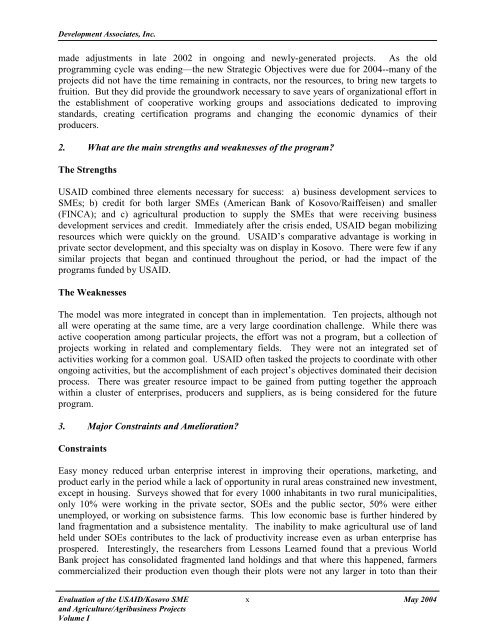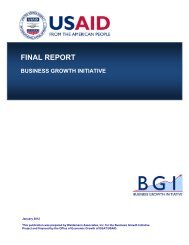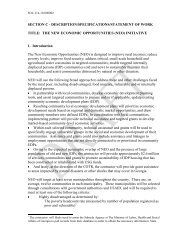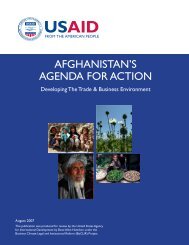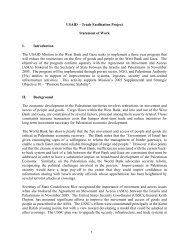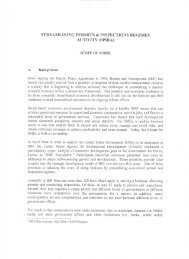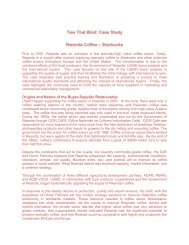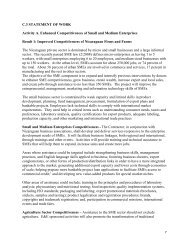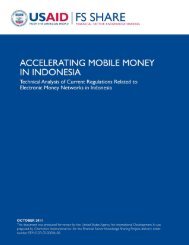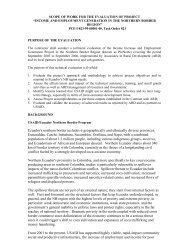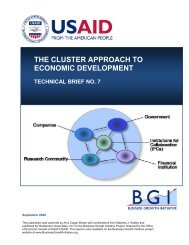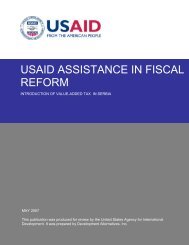Evaluation of the USAID-Kosovo SME and Agriculture - Economic ...
Evaluation of the USAID-Kosovo SME and Agriculture - Economic ...
Evaluation of the USAID-Kosovo SME and Agriculture - Economic ...
Create successful ePaper yourself
Turn your PDF publications into a flip-book with our unique Google optimized e-Paper software.
Development Associates, Inc.made adjustments in late 2002 in ongoing <strong>and</strong> newly-generated projects. As <strong>the</strong> oldprogramming cycle was ending—<strong>the</strong> new Strategic Objectives were due for 2004--many <strong>of</strong> <strong>the</strong>projects did not have <strong>the</strong> time remaining in contracts, nor <strong>the</strong> resources, to bring new targets t<strong>of</strong>ruition. But <strong>the</strong>y did provide <strong>the</strong> groundwork necessary to save years <strong>of</strong> organizational effort in<strong>the</strong> establishment <strong>of</strong> cooperative working groups <strong>and</strong> associations dedicated to improvingst<strong>and</strong>ards, creating certification programs <strong>and</strong> changing <strong>the</strong> economic dynamics <strong>of</strong> <strong>the</strong>irproducers.2. What are <strong>the</strong> main strengths <strong>and</strong> weaknesses <strong>of</strong> <strong>the</strong> program?The Strengths<strong>USAID</strong> combined three elements necessary for success: a) business development services to<strong>SME</strong>s; b) credit for both larger <strong>SME</strong>s (American Bank <strong>of</strong> <strong>Kosovo</strong>/Raiffeisen) <strong>and</strong> smaller(FINCA); <strong>and</strong> c) agricultural production to supply <strong>the</strong> <strong>SME</strong>s that were receiving businessdevelopment services <strong>and</strong> credit. Immediately after <strong>the</strong> crisis ended, <strong>USAID</strong> began mobilizingresources which were quickly on <strong>the</strong> ground. <strong>USAID</strong>’s comparative advantage is working inprivate sector development, <strong>and</strong> this specialty was on display in <strong>Kosovo</strong>. There were few if anysimilar projects that began <strong>and</strong> continued throughout <strong>the</strong> period, or had <strong>the</strong> impact <strong>of</strong> <strong>the</strong>programs funded by <strong>USAID</strong>.The WeaknessesThe model was more integrated in concept than in implementation. Ten projects, although notall were operating at <strong>the</strong> same time, are a very large coordination challenge. While <strong>the</strong>re wasactive cooperation among particular projects, <strong>the</strong> effort was not a program, but a collection <strong>of</strong>projects working in related <strong>and</strong> complementary fields. They were not an integrated set <strong>of</strong>activities working for a common goal. <strong>USAID</strong> <strong>of</strong>ten tasked <strong>the</strong> projects to coordinate with o<strong>the</strong>rongoing activities, but <strong>the</strong> accomplishment <strong>of</strong> each project’s objectives dominated <strong>the</strong>ir decisionprocess. There was greater resource impact to be gained from putting toge<strong>the</strong>r <strong>the</strong> approachwithin a cluster <strong>of</strong> enterprises, producers <strong>and</strong> suppliers, as is being considered for <strong>the</strong> futureprogram.3. Major Constraints <strong>and</strong> Amelioration?ConstraintsEasy money reduced urban enterprise interest in improving <strong>the</strong>ir operations, marketing, <strong>and</strong>product early in <strong>the</strong> period while a lack <strong>of</strong> opportunity in rural areas constrained new investment,except in housing. Surveys showed that for every 1000 inhabitants in two rural municipalities,only 10% were working in <strong>the</strong> private sector, SOEs <strong>and</strong> <strong>the</strong> public sector, 50% were ei<strong>the</strong>runemployed, or working on subsistence farms. This low economic base is fur<strong>the</strong>r hindered byl<strong>and</strong> fragmentation <strong>and</strong> a subsistence mentality. The inability to make agricultural use <strong>of</strong> l<strong>and</strong>held under SOEs contributes to <strong>the</strong> lack <strong>of</strong> productivity increase even as urban enterprise hasprospered. Interestingly, <strong>the</strong> researchers from Lessons Learned found that a previous WorldBank project has consolidated fragmented l<strong>and</strong> holdings <strong>and</strong> that where this happened, farmerscommercialized <strong>the</strong>ir production even though <strong>the</strong>ir plots were not any larger in toto than <strong>the</strong>ir<strong>Evaluation</strong> <strong>of</strong> <strong>the</strong> <strong>USAID</strong>/<strong>Kosovo</strong> <strong>SME</strong> x May 2004<strong>and</strong> <strong>Agriculture</strong>/Agribusiness ProjectsVolume I


